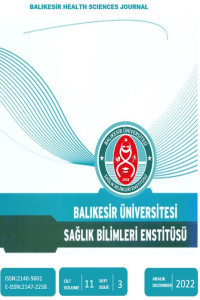TERM YENİDOĞANDA KENDİLİĞİNDEN DÜZELEN SAFRA ÇAMURU; BİR OLGU SUNUMU
Safra çamuru yenidoğanlarda çok nadiren gözlenmektedir. Çoğu tesadüfen saptanır. Bildirilen olguların çoğu ilaç kullanımı ile ilişkilidir. Birçok olgu ise idiopatiktir. Hipotroidizm diğer bir nadir nedendir. Bu yazımızda iki günlük iken tanı konulan bir hastamızı bildirdik. Belirgin bir etiyolojik neden saptanamadı. Klinik bulgu tespit edilmeyen hastanın izleminde kendiliğinden düzelme gözlendi. Safra çamuru kendiliğinden düzelebileceği gibi bazen safra taşlarına ilerleme gösterebilir. Nadiren oldukça ciddi komplikasyonlar oluşturabilmektedir. Etiyolojik açıdan risk taşıyan hastalar uzun süreli ve yakın izlenmelidir.
Anahtar Kelimeler:
mikrokristal, safra çamuru
SPONTANEOUSLY RESOLVED BILIARY SLUDGE IN A TERM NEONATE; A CASE REPORT
Biliary sludge is rarely observed in newborns. Most of them are diagnosed incidentally. The majority of reported cases are related with drug use. And most cases are idiopathic. Hypothyroidism is another rare cause. In this article we reported a patient who was diagnosed when he was two days old in. An etiological cause was not found. The patient had no clinical finding and the sludge resolved spontaneously at follow up period. Biliary sludge may resolve spontaneously or sometimes may proceed to gallstones. Rarely can lead to serious complications. The patients with etiological risks should be followed up closely for a long period.
Keywords:
microcrystal, biliary sludge,
___
- 1. Ko CW, Sekijima JH, Lee SP. Biliary sludge. Ann Intern Med. 1999; 130: 301-311.
- 2. Abeysuriya V, Deen KI, Navarathne NM. Biliary microlithiasis, sludge, crystals, microcrystallization, and usefulness of assessment of nucleation time. Hepatobiliary Pancreat Dis Int. 2010; 9: 248-253.
- 3. Soysal A, Eraşov K, Akpinar I, Bakir M. Biliary precipitation during ceftriaxone therapy: frequency and risk factors. Turk J Pediatr. 2007; 49: 404-407.
- 4. Kurtoğlu S, Coban D, Akın MA, Akın L, Yıkılmaz A. Neonatal sludge: a finding of congenital hypothyroidism. J Clin Res Pediatr Endocrinol. 2009; 1: 197-200.
- 5. Ozturk A, Kaya M, Zeyrek D, Ozturk E, Kat N, Ziylan SZ. Ultrasonographic findings in ceftriaxone: associated biliary sludge and pseudolithiasis in children. Acta Radiol. 2005; 46: 112-116.
- 6. Acun C, Erdem LO, Sogut A, Erdem CZ, Tomac N, Gundogdu S. Ceftriaxone-induced biliary pseudolithiasis and urinary bladder sludge. Pediatr Int. 2004; 46: 368-370.
- 7. Karakitsos D, Poularas J, Samonis G, Karabinis A. Ceftriaxone-associated reversible biliary sludge in a critical care patient. Acta Anaesthesiol Scand. 2008; 52: 1171-1172.
- 8. Bor O, Dinleyici EC, Kebapci M, Aydogdu SD.Ceftriaxone-associated biliary sludge and pseudocholelithiasis during childhood: a prospective study. Pediatr Int. 2004; 46: 322-324.
- 9. Araz N, Okan V, Demirci M, Araz M. Pseudolithiasis due to ceftriaxone treatment for meningitis in children: report of 8 cases. Tohoku J Exp Med. 2007; 211: 285-290.
- 10. Biner B, Oner N, Celtik C, Bostancioğlu M, Tunçbilek N, Güzel A, Karasalihoğlu S. Ceftriaxone-associated biliary pseudolithiasis in children. J Clin Ultrasound. 2006; 34: 217-222.
- 11. Araz NC, Demirci M Ceftazidime-associated biliary sludge in neonatal sepsis: a first report. J Chemother. 2009; 21: 703-704.
- ISSN: 2146-9601
- Yayın Aralığı: Yılda 3 Sayı
- Başlangıç: 2012
- Yayıncı: Balıkesir Üniversitesi
Sayıdaki Diğer Makaleler
TERM YENİDOĞANDA KENDİLİĞİNDEN DÜZELEN SAFRA ÇAMURU; BİR OLGU SUNUMU
Selçuk YAZICI, Bahar YANIK KEYİK
HALLUKS RİJİDUSTA KULLANILAN TEDAVİ SEÇENEKLERİ
Gökhan MERİÇ, Aydın BUDEYRİ, Koray BAŞDELİOĞLU, Aykut DEMİR, Ali Engin UYSAL
OMEGA–3 YAĞ ASİTLERİNİN BÖBREK ANTİOKSİDAN SAVUNMA SİSTEMİ ÜZERİNDEKİ ETKİSİ: DENEYSEL BİR ÇALIŞMA
Burak GÜLCEN, Ömür KARACA, Murat Abdulgani KUŞ, Dilara KAMAN, Murat ÖGETÜRK, İlter KUŞ
